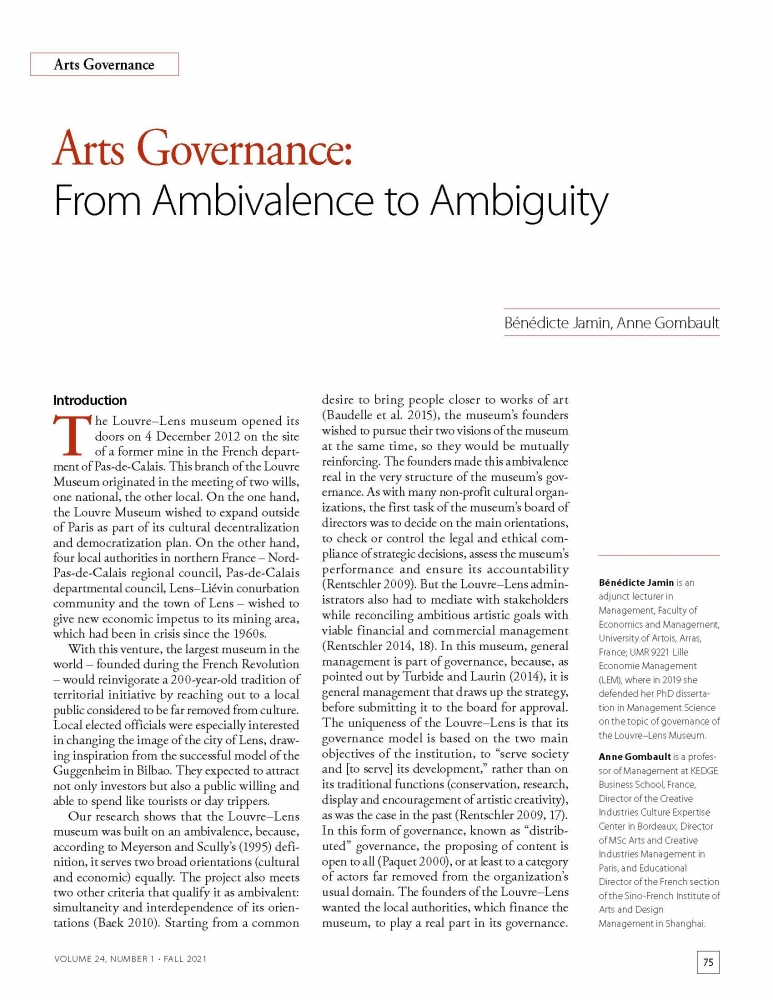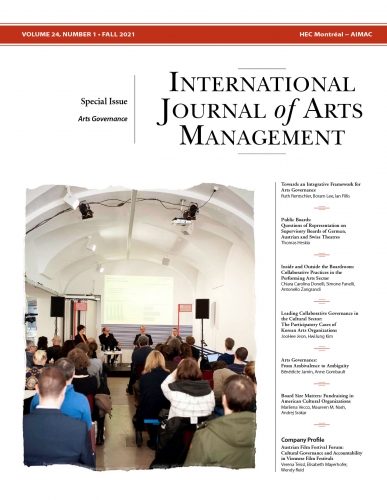Arts Governance: From Ambivalence to Ambiguity
Product: Article
$21.00 CA
Bénédicte Jamin is an adjunct lecturer in Management, Faculty of Economics and Management, University of Artois, Arras, France; UMR 9221 Lille Economie Management (LEM), where in 2019 she defended her PhD dissertation in Management Science on the topic of governance of the Louvre–Lens Museum.
Anne Gombault is a professor of Management at KEDGE Business School, France, Director of the Creative Industries Culture Expertise Center in Bordeaux, Director of MSc Arts and Creative Industries Management in Paris, and Educational Director of the French section of the Sino-French Institute of Arts and Design Management in Shanghai.
ABSTRACT
This article examines the relevance of ambivalence as a strategic choice, which is both a guarantee of success and a source of risk, in the governance of arts and cultural organizations. The longitudinal qualitative study examines the unique case of Louvre–Lens, a branch of the Louvre Museum. The branch was created in 2012 with two objectives: a national plan for cultural centralization, and economic revitalization of an area in crisis. The authors show that governance based on an ambivalence of objectives was promising at first but then the ambivalence turned into ambiguity. The ambiguity disrupted the functioning of the museum, as it contributed to the sowing of doubt and suspicion among board members regarding the distribution of their roles and missions. The study’s first contribution concerns the benefits of ambivalence in governance, responding to the widening responsibilities of museum branches that now extend beyond the cultural domain. Its second contribution is to highlight the risk factors that turn ambivalence into ambiguity: the vision of the founders, the leadership, and attendance figures are all points that must not escape the vigilance of governance actors.
KEYWORDS
Arts governance, ambivalence, ambiguity, sensemaking, leadership, museum
RÉSUMÉ
Cette étude examine la pertinence de l’ambivalence en tant que choix stratégique, lequel peut être à la fois une garantie de succès et une source de risques dans la gouvernance des arts et des organismes culturels. L’étude qualitative longitudinale se penche sur le cas unique du Louvre-Lens, une division du musée du Louvre. L’établissement a été inauguré en 2012 avec deux objectifs : la mise en œuvre d’un plan national de décentralisation culturelle et la revitalisation économique d’un territoire en crise. Les auteures montrent que la gouvernance fondée sur l’ambivalence des objectifs était d’abord prometteuse, mais que l’ambivalence a fini par se transformer en ambiguïté. L’ambiguïté a perturbé le fonctionnement du musée en semant le doute et en suscitant des soupçons parmi les membres du conseil d’administration au sujet de la répartition de leurs rôles et missions. La première contribution de l’étude concerne les avantages de l’ambivalence dans la gouvernance, répondant à l’élargissement des responsabilités des divisions muséales qui s’étendent maintenant au-delà du domaine culturel. Sa deuxième contribution consiste à mettre en lumière les facteurs de risque qui transforment l’ambivalence en ambiguïté : la vision des fondateurs, le leadership et les chiffres de fréquentation sont tous des paramètres qui ne doivent pas échapper à la vigilance des acteurs de la gouvernance.
MOTS CLÉS
Gouvernance des arts, ambivalence, ambiguïté, recherche de sens, leadership, musée

